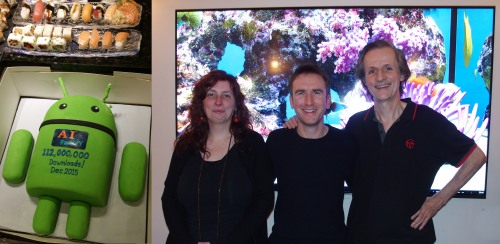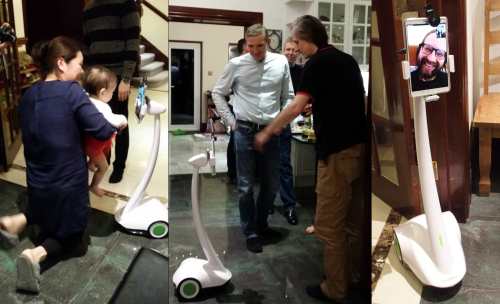This issue has extraordinarily and uncommonly come out on time, so does not lag far behind the previous issue that was late, only 2 months ago. So, in theory the volume of news may appear a little thin. However in the last 12 months we have had 22 million more users, now totalling 112 million, so are now reaching many more users. With this has come new work that we have had to pursue.
We recently had our biggest company party yet and (below) you can see our even bigger Android cake. We also took the chance to re-assemble the crew in-front of our now 8-year old aquarium product, originally destined for old slow handsets, so heavily optimised. Even though the product was designed for very old slow GPU hardware, its low GPU demand still looks pretty good on our 79" TV. This was a good product that did a good job emulating fish using biological emulation. Each fish could "see" ahead of it and then make decisions about what it might do next. This was all highly parameterised so that new fish could be created with no new code code. This could successfully show shoaling behaviour. It was even used to emulate a toy submarine.

Some fun was had at the party with a telepresent PadBot that allowed a colleague to join the party from Seattle and also Barcelona. We actually also had telepresent screens but in the melee of trying to host a party and keep all this going, one screen was plugged in, but power off, and the remaining screen and PadBot did not get the needed tech support to keep things running smoothly. It all went swingingly in practice but the noise of the party overwhelmed the half duplex communication to believe that the person at the party never stopped talking, so we rarely got to hear what our remote guest was saying. We will solve this next year with a proximity microphone. Mads Haahr in Barcelona had some fun as a padbot with the juniors at the party.

As indicated in the newsletter header, a significant activity has been the conversion from Eclipse to Android Studio. That such a change would be in the offing is no surprise because as Android has blown up from a tiny market share to its current huge and dominating size, it increasingly seems odd that app development depended on an external free IDE. The switch was quite a lot of work but we found a gap where all else would shut-down while this transition happened. This is "for life" now as we are now hooked to this Google-own product. As it evolves we are sure that the technical advantages it offers will gradually make our life easier. Gone are the days when Eclipse would hang or crash, going through phases where it refused to build and a PC re-boot had to be resorted to. We are through the pain barrier of the conversion and look forward to the broad, sunlit uplands of future development (to steal a quote).
Although awaiting the next release, we are becoming more focussed on building the user experience of our apps. You just have to look at Candy Crush to see how a simple move results in an avalanche of win responses. Users are being trained to get a barrage of rewards for their play and gradually our apps will need to follow something of this trend. The current app to be updated follows something of this ethos. This will be an experiment for us that may see follow-ons in future products.
However the biggest event these last two months, in terms of advancing our progress, as been Google's introduction of A/B experiments built into the Android console. These allow the developer to test alternative store features against the current default, by diverting a section of users to use the alternative versions. This can be used to test short descriptions, feature graphics etc. Of course, to a limited extent, we have tried to do such work before. However this was never easy. The key is to extract out changes in downloads from the continuous fluctuation and noise in the market. Our previous attempts at this required comparing the app being tested against the geometric mean of the progress of all our other apps. This did a reasonable job, in that a noisy download graph indeed reduced to a fairly flat graph, with a rise or dip where the change was made. However this was not noise-free and assumed that other apps suffered from the same dips and rises in unison. This was not a totally invalid assumption but not a pure result. Finally this took a great deal of work. The new Google A/B testing though is essentially noise free and really quick and easy to use. It has exposed aspects of market response that were undetectable by other means but mostly made it easy to run many experiments at once with little effort. The net impact has seen a substantial improvement in our downloads. This has truly been low hanging fruit.
We enter the end of year a tad tired as 66% of the company moved house late in the year and so energy has seeped away. We are closing out this year clearing our decks and in January can come back afresh to see how we carry AI Factory into 2016!
